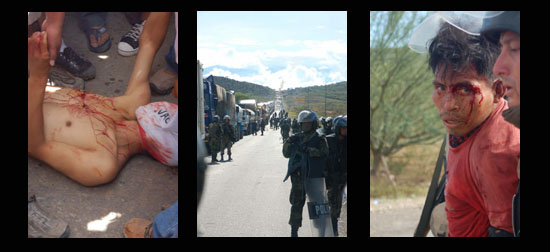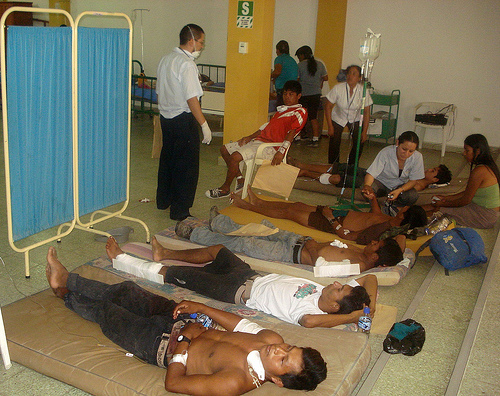
It's 2009 and Indian people are still being killed for their land and natural resources. After 56 days of peaceful protests by indigenous people struggling to protect their land from oil drilling, mining and other mega-developments, President Alan Garcia sent troops to Bagua Grande, 870 miles north of Lima. On June 5, police opened fire on the protesters at Devil's Curve outside of Bagua, and confrontations ensued throughout the following days. Violence was also reported at Station 6, an oil facility some distance from Bagua that had been under the control of indigenous protesters. Though media reports of this incident are scarce, a number of police were reported killed.
 |
Official government reports of the violence put the total death toll at 34 (24 police and 10 protesters and civilians), though indigenous organizations and local residents say the number of indigenous people still unaccounted for is much higher. Further investigation has been especially difficult due to the police's closure of the site of the conflict for nearly a week and the almost total lack of evidence remaining once the area was reopened.
In the wake of the confrontation, Alberto Pizango, the president of the Interethnic Peruvian Jungle Development Association (AIDESEP), the indigenous organization leading the protests, was granted asylum in Nicaragua. Several other indigenous leaders sought asylum or returned to their communities to avoid arrest and prosecution. Tens of thousands of protesters gathered in Lima and other Peruvian cities to denounce the government's repression in Bagua and to call for reform of the country's economic and development policy.
AIDESEP's immediate demands include the dropping of all charges against Alberto Pizango and other indigenous leaders. They also seek the repeal of legislative decrees affecting indigenous people's land rights, traditional knowledge and economic, social and cultural rights, as well as those that criminalize indigenous protest. They have called on the government to adopt laws requiring the free, prior, and informed consent of indigenous peoples before engaging in development projects that would affect them, in accordance with ILO Convention 169. They have also demanded the government incorporate the provisions of the U.N. Declaration on the Rights of Indigenous Peoples into Peru's domestic legal framework.
In response to protesters' demands, the Peruvian government repealed two controversial decrees relating to forest management and natural resources. Government officials and some indigenous leaders - notably without the participation of many who are in custody or in hiding from police - have convened a negotiating table to discuss new development policies for the Amazon to replace the repealed decrees. In early July, the Peruvian Congress held a public hearing in which the Prime Minister and Minister of the Interior were questioned about the Bagua incidents. Following this hearing, the Prime Minister resigned, assuming the "political cost" of the conflict in the Amazon, and since then, the entire cabinet has been replaced.
The photos on this page were sent to us from Ben Powless who was on the ground helping Amazonian peoples of Peru get information out. (There are many more photos on his flickr site) Check back for updates.
Please SEND A MESSAGE to President Garcia and the embassy of Peru at: [email protected] or [email protected]
Here are links to several stories about the situation:______________
[21 July 2009] Garcia’s Decline in Peru Council on Hemispheric Affairs Article
[20 July 2009] Observations of the UN Special Rapporteur on the human rights and fundamental freedoms of indigenous people (Only available in Spanish).
[19 July 2009] Peru's Cold War Against Indigenous People Word Press Article
[12 June 2009] Indigenous Protest and State Violence in the Peruvian Amazon: How the Media Misrepresents Huffington Post Article
[10 June 2009] Disputed Peru land laws suspended BBC Article
Ben Powless's blog: http://rabble.ca/blogs/bloggers/ben-powless
More photos on Ben's flicker site http://www.flickr.com/photos/powless
Peruanista blog: http://peruanista.blogspot.com/
To see more stories on this issue, please click here.
For more background on indigenous land rights____________________
Please see links to ILO Convention 169 (Articles 13-18), UN Declaration on the Rights of Indigenous Peoples (specifically Articles 26-32), ILRC paper on Multilateral Development Banks, and UN documents on Indigenous Peoples' Permanent Sovereignty over Natural Resources and Indigenous Peoples and Their Relationship to Land.
Indigenous peoples and their relationship to land
Final working paper prepared by the Special Rapporteur, Erica-Irene A. Daes
11 June 2001
Indigenous peoples' permanent sovereignty over natural resources
Final report of the Special Rapporteur, Erica-Irene A. Daes
13 July 2004
Principles of International Law for Multilateral Development Banks
The Obligation to Respect Human Rights | January, 2009
Paper prepared by Robert T. Coulter, Leonardo A. Crippa, Emily Wann